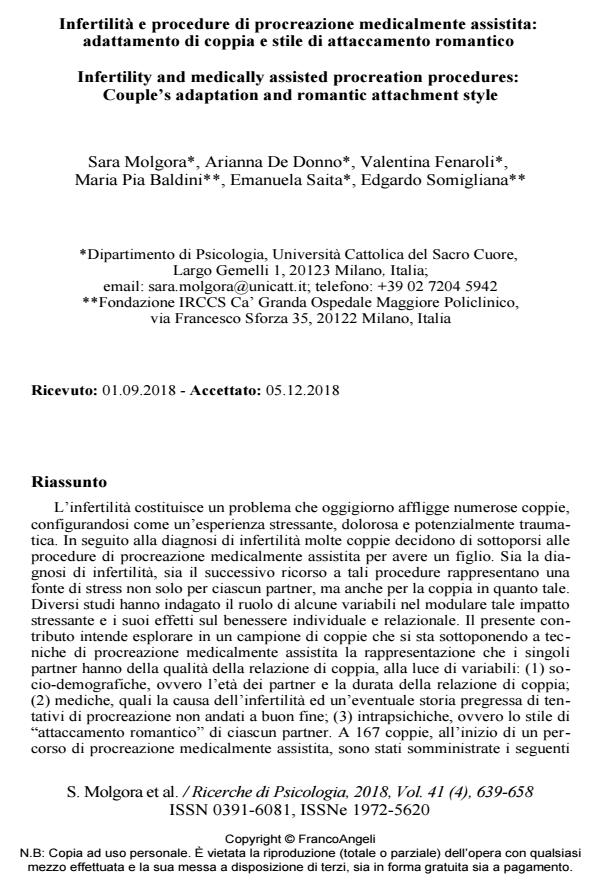Infertilità e procedure di procreazione medicalmente assistita: adattamento di coppia e stile di attaccamento romantico
Titolo Rivista RICERCHE DI PSICOLOGIA
Autori/Curatori Sara Molgora, Arianna De Donno, Valentina Fenaroli, Maria Pia Baldini, Emanuela Saita, Edgardo Somigliana
Anno di pubblicazione 2019 Fascicolo 2018/4
Lingua Italiano Numero pagine 20 P. 639-658 Dimensione file 205 KB
DOI 10.3280/RIP2018-004006
Il DOI è il codice a barre della proprietà intellettuale: per saperne di più
clicca qui
Qui sotto puoi vedere in anteprima la prima pagina di questo articolo.
Se questo articolo ti interessa, lo puoi acquistare (e scaricare in formato pdf) seguendo le facili indicazioni per acquistare il download credit. Acquista Download Credits per scaricare questo Articolo in formato PDF

FrancoAngeli è membro della Publishers International Linking Association, Inc (PILA)associazione indipendente e non profit per facilitare (attraverso i servizi tecnologici implementati da CrossRef.org) l’accesso degli studiosi ai contenuti digitali nelle pubblicazioni professionali e scientifiche
L’infertilità costituisce un problema che oggigiorno affligge numerose coppie, configurandosi come un’esperienza stressante, dolorosa e potenzialmente trau-matica. In seguito alla diagnosi di infertilità molte coppie decidono di sottoporsi alle procedure di procreazione medicalmente assistita per avere un figlio. Sia la diagnosi di infertilità, sia il successivo ricorso a tali procedure rappresentano una fonte di stress non solo per ciascun partner, ma anche per la coppia in quanto ta-le. Diversi studi hanno indagato il ruolo di alcune variabili nel modulare tale im-patto stressante e i suoi effetti sul benessere individuale e relazionale. Il presente contributo intende esplorare in un campione di coppie che si sta sottoponendo a tecniche di procreazione medicalmente assistita la rappresentazione che i singoli partner hanno della qualità della relazione di coppia, alla luce di variabili: (1) so-cio-demografiche, ovvero l’età dei partner e la durata della relazione di coppia; (2) mediche, quali la causa dell’infertilità ed un’eventuale storia pregressa di ten-tativi di procreazione non andati a buon fine; (3) intrapsichiche, ovvero lo stile di "attaccamento romantico" di ciascun partner. A 167 coppie, all’inizio di un percorso di procreazione medicalmente assistita, sono stati somministrate i seguenti strumenti: Dyadic Adjustment Scale; Experience in Close Relationship Que-stionnaire; scheda per la raccolta di dati socio-anagrafici e informazioni medi-che. I risultati indicano che né le variabili socio-anagrafiche (età dei partner e du-rata della relazione), né le variabili mediche (diagnosi, numero dei tentativi e tipo-logia di trattamento) sembrano avere alcun effetto sull'adattamento di coppia, sia nel campione delle donne che in quello degli uomini. Di contro, emerge un ef-fetto significativo dell’ansia di abbandono e dell’evitamento sull’adattamento di coppia nelle donne, mentre solo dell’evitamento sull’adattamento di coppia negli uomini. Tali risultati mostrano la presenza di differenze di genere, connesse con le specifiche modalità di vivere ed affrontare l’esperienza dell’infertilità negli uomi-ni e nelle donne. Inoltre, mettono in luce come la coppia sembra in questa fase specifica configurarsi come un contenitore di alcune fatiche che risultano essere più di natura individuale, interrogando clinici ed operatori sociali sul tipo di inter-vento psicologico più adatto in questa delicata fase.
Parole chiave:Infertilità, procreazione medicalmente assistita, adattamento di coppia, stile di attaccamento romantico.
- Individual and Relational Well-Being at the Start of an ART Treatment: A Focus on Partners’ Gender Differences Sara Molgora, Maria Pia Baldini, Giancarlo Tamanza, Edgardo Somigliana, Emanuela Saita, in Frontiers in Psychology 2027/2020
DOI: 10.3389/fpsyg.2020.02027 - Quality of life and infertility stress in homologous and heterologous medically assisted reproduction: The role of common and specific psychopathological traits Andrea Pozza, Davide Dèttore, Maria E. Coccia, in Perspectives in Psychiatric Care /2021 pp.717
DOI: 10.1111/ppc.12603
Sara Molgora, Arianna De Donno, Valentina Fenaroli, Maria Pia Baldini, Emanuela Saita, Edgardo Somigliana, Infertilità e procedure di procreazione medicalmente assistita: adattamento di coppia e stile di attaccamento romantico in "RICERCHE DI PSICOLOGIA " 4/2018, pp 639-658, DOI: 10.3280/RIP2018-004006